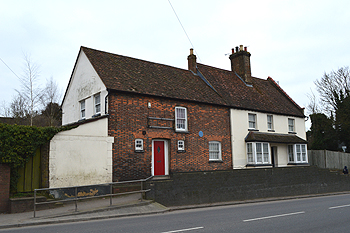The Half Moon Public House Kensworth
 The old Half Moon Inn February 2013
The old Half Moon Inn February 2013
The Half Moon Public House: Watling Street, Kensworth [now Dunstable]
Kensworth had two drinking establishments called The Half Moon, one, this one, a public house; the other a beerhouse. It seems, at first glance, very strange to have two licensed premises of the same name in the same village but they were a long way apart. The Half Moon beerhouse was in the village whereas the Half Moon Public House was at the extreme north-east tip of the parish and, today, since boundary changes in 1985, is well inside Dunstable.
Kensworth was in Hertfordshire until 1897 when it transferred to Bedfordshire. The 1891 census reveals information about the licensee for over twenty years – Thomas Partridge. At that date he was 66. He had been born in Ivinghoe in Buckinghamshire. His wife, Martha, was a year younger than him and had been born in Tebworth.
The countywide licensing register of 1903 states that the owner of the establishment was Watford [Hertfordshire] brewer, Benskin & Company Limited. The public house needed cleaning and sanitation was not satisfactory. It was 370 yards from the nearest licensed premises and had both a front door and a door from the yard at the side. The unsatisfactory sanitation may have had a hand in the closure of the premises ten years later.
In Volume II of The Bedfordshire Magazine [page 289] in 1950/51 Page Woodcock wrote a distinctly colourful account of the pub: "South of the town stood a toll-gate. Coaches could not avoid it but market goers and drovers escaped the toll by leaving the Watling Street bear the Pack Horse, following the old Drover's Way, and rejoining the main road by the Half Moon, doubtless spending their resultant saving at the small tavern on the high bank. To-day, half Moon Dairy is all that is left of thos once colourful tavern. It was the first call from the south for packhorse drivers, London journeymen and pedlars. Local lore says that the highwaymen who picketed the road made it their headquarters. Authority Worthington Smith conjures up a picture of even earlier days. Behind the Half Moon, he sites the bull-baiting ring of Stuart times, when rich and poor alike goaded the unfortunate animal with knives, sticks and whips until it bled to death; this treatment was supposed to make the flesh more tender".
"The orthodox may theorize about crescents and crusaders for the origin of this tavern's title; but for the record, when Spittal Hill led out of a smaller Dunstable to 'Markyatstrete', in the latter district one family is recorded for generations - the Munes or Moons. They owned the land and probably the bull-ring. 'A punning title, the Half Moon' Pryce Jones suggested. i studied my notes and found that m'lady Moon was once represented as a goddess 'in a short coat and a long-eared cap'. Pryce Jones began murmuring unkind things about full moons and long-eared March hares".
The Half Moon was listed by the former Department of Environment in March 1976. It dates from the 17th century or earlier - "altered but retaining a largely complete timber frame". The property comprising the right had section, 1 and 2 Old Half Moon House, has been rendered and comprises two storeys beneath an old clay tiled roof. 3 Old Half Moon House is brick built with some vitrified bricks, again the roof is tiled, it looks like a former outbuilding to 1 and 2 Old Half Moon House.

Plaque on the Half Moon February 2013
References:
- PSL6/1: Register of Alehouse Licences - Luton Petty Sessional Division: 1872-1901.
List of Licensees: note that this is not a complete list. Italics indicate licensees whose beginning and/or end dates are not known:
1847-1861 Charles Horn
1871-1891: Thomas Partridge
1896-1899: Thomas Turner;
1899-1906: George Pratt;
1906-1908: Francis Marshall;
1908: Charles Pedley;
1908-1913: Thomas Bullman
Public House closed 30th September 1913.